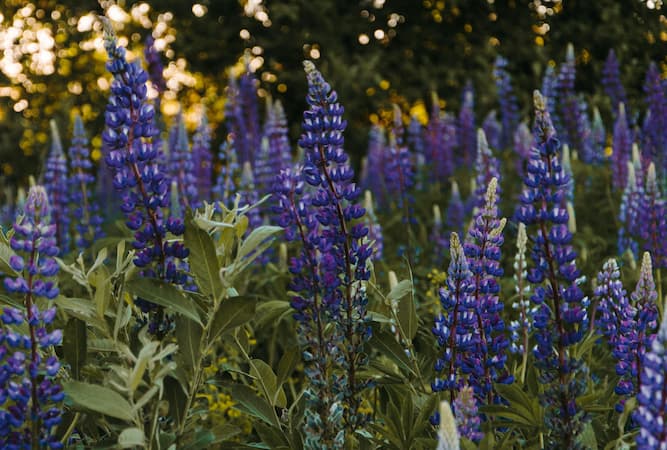How to Grow and Care for Lupine Flowers

About Growing Lupine Plants in Your Home Flower Garden
A member of the pea family, Lupines plants produce a wonderful, old-fashioned flower. There are annual and perennial varieties. They bear very large, showy spikes covered with unusual pea-like florets on long, sturdy stems. The plants have attractive, handprint-shaped blue-green leaves. If you have never grown these attractive flowers before, you are in for a treat. Use this guide to learn how to grow Lupine flowers. Then, plant some lupine seeds, and you are on your way to a beautiful flower garden.
If you’ve ever seen a field filled with Lupines in bloom you know that these wildflowers tolerate a little crowding. Easy, quick-growing Lupine plants rise to produce tall, stately spikes. The plants prefer cool weather climates.
Lupines are great as a cut flower in vases, alone by themselves, or in arrangements.
Strange as it may seem, some Lupines are poisonous, while others are edible! Unless you know our Lupines, we recommend you do not serve them at the dinner table.
Lupine Flower Plant Specifications
Flower Colors: Flower colors include white, red, pink, blue, yellow, lilac, violet, and apricot.
Flowers Bloom: Late Spring to early Summer.
Plant Height: Eighteen inches to four feet tall, depending upon variety.
Ideal Soil pH: 5.0 – 7.0.
Light Requirement: Full sun.
Hardiness Zones: 4 – 8
Are Lupines Toxic? Yes. The plants are toxic to humans and animals.
Deer Resistant? Yes
Number of Species: Over 200 species.
Native To: North America.
Plant Type: Annuals and Perennials
Name: Lupinus
Other Names: Texas Bluebonnet
Are Lupines Edible?
NO!!
Lupines are a toxic plant. They are poisonous for humans, pets and farm animals. If you have small children, we suggest you grow another plant for their safety.
Light Requirements
Grow Lupine flowers in bright, direct sunlight. Select a planting location where they will receive at least seven to eight hours of sunlight. In hotter regions of the country, grow them where they are partially shaded from the hot afternoon sun.
While they will grow in partial shade, it affects the health and production of the plant. In too little sunlight the plant grows leggy. It also results in fewer blossoms.
Lupine Flower Plant Propagation
Start plants from seed. Sow Lupine seeds directly into your flower garden after all danger of frost. They can also be spread around fields as a wildflower.
plant seeds 6-8 weeks before the last frost in your area. Because germination time is very long, we recommend an indoor start. Plant Lupine seeds 6-8 weeks before the last frost in your area. We recommend using a seed germination mat for a faster, and higher, more successful germination rate.
Sow seeds and cover lightly with 1/8″ of fine garden soil, or seed starting soil. Water the plants lightly. Then, keep the soil moist, not wet until the seeds sprout.
Final Plant Spacing: Space plants 12″ – 14″ apart.
Perennial Lupines can be propagated by cuttings or division. Make cuttings in late summer as the weather begins to cool. Plant division is best done in the early fall.
Days to Germination: 25 – 30 days.
How to Grow Lupine Plants
Select a planting site where Lupine plants like full sun. They will grow in light, partial shade. Lupine will do well in average soils and cool weather. They will grow quickly to a height of 4 feet for the tallest varieties.
The soil should be loose and lime-free (they do not like lime).
Keep the soil moist to feed their quick growth. Water them during dry periods, once or twice per week.
Adding a general-purpose fertilizer once a month before blooming will result in bigger plants and blooms.
Tip: Apply a thick layer of mulch, to help retain soil moisture, cool roots, and for winter protection in colder regions.
Deadhead spent blooms to prolong the blooming period.
Growing Lupine Plants in Containers and Flowerpots
Lupine plants are not commonly grown in containers and flowerpots. However, shorter varieties may look good in containers in some settings. In addition to the normal steps for growing them, here’s how to care for them in a flowerpot:
- It is important to have a drain hole to allow excess water to drain from the pot.
- Keep an eye on the moisture level. Check the plants every day or two, especially in extended periods of hot, dry weather.
- Keep the soil moist, but not wet. It is okay to let the top of the soil begin to dry between watering.
- When watering the plants, thoroughly wet the soil. Excess water will drain through the hole in the bottom of the flowerpot.
- Nutrients in a flowerpot are limited. So, use fertilizer spikes to feed the plants. Or, apply a light solution of liquid fertilizer once a month.
- Select a sunny to partly sunny location on your deck.
Pruning Lupine Flowers
This plant is about as maintenance free as they come. No regular pruning is needed.
To improve appearance, you can remove any dead or damaged stems and leaves.
Insects and Plant Disease
Usually, there are no insect or plant disease problems.
However, if problems occur, treat early with organic or chemical insect repellents and fungicide.
Also see: Plant Problems – Identify the causes and find the cures.
Overwintering Lupine Plants
Annual varieties will die off after the first frost in your area.
Perennial varieties do not require any special winter protection.
Related Articles
Also, people who read this article will like:
How to Grow Lupine Plants – by Garden Hobbies
Please support our site. Shop for:
- rmmatthews100@hotmail.com
- 585-721-6528
- Rochester, NY
©1999-2024 GardenersNet.Com, All Rights Reserved

